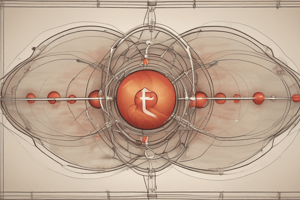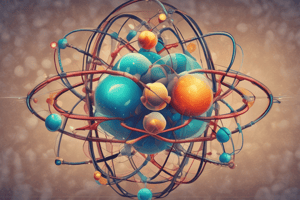Podcast
Questions and Answers
What is the primary function of the endocrine system?
What is the primary function of the endocrine system?
- To produce and regulate chemical substances called hormones (correct)
- To maintain blood pressure
- To regulate the heartbeat
- To regulate body temperature
What is the term used to describe the constant state of the internal environment?
What is the term used to describe the constant state of the internal environment?
- Endocrine system
- Homeostasis (correct)
- Hormone regulation
- Metabolism
What do hormones regulate in the body?
What do hormones regulate in the body?
- Respiratory and circulatory systems
- Muscle movement and nerve function
- Blood pressure and body temperature
- Growth, development, mood, tissue function, metabolism, and sexual function (correct)
What is released in small amounts from glands and transported in the bloodstream to target organs or cells?
What is released in small amounts from glands and transported in the bloodstream to target organs or cells?
Which gland is considered the master gland in the endocrine system?
Which gland is considered the master gland in the endocrine system?
What would happen if homeostasis fails?
What would happen if homeostasis fails?
What is the primary function of hormones in the body?
What is the primary function of hormones in the body?
Which gland produces hormones that stimulate or suppress hormone secretions?
Which gland produces hormones that stimulate or suppress hormone secretions?
What is the result of an excess of thyroxine in the body?
What is the result of an excess of thyroxine in the body?
What is the term for the body's automatic response to perceived threats?
What is the term for the body's automatic response to perceived threats?
What is the role of the pituitary gland in hormone regulation?
What is the role of the pituitary gland in hormone regulation?
What would be the result of a break in the hormone regulation pathway?
What would be the result of a break in the hormone regulation pathway?
What is the primary purpose of responding to stimuli in humans?
What is the primary purpose of responding to stimuli in humans?
What is the term used to describe a change in the environment?
What is the term used to describe a change in the environment?
What do human senses include?
What do human senses include?
What happens when a stimulus is detected by a sensor?
What happens when a stimulus is detected by a sensor?
Where can the signal from a sensor be processed?
Where can the signal from a sensor be processed?
What is the charge of a neutron?
What is the charge of a neutron?
What is the number of electrons in the first shell of an atom?
What is the number of electrons in the first shell of an atom?
What is the relationship between the number of protons and electrons in an atom?
What is the relationship between the number of protons and electrons in an atom?
What is the term for the arrangement of electrons in energy levels around the nucleus of an atom?
What is the term for the arrangement of electrons in energy levels around the nucleus of an atom?
What is the atomic number of an atom equal to?
What is the atomic number of an atom equal to?
What is the atomic mass of an atom equal to?
What is the atomic mass of an atom equal to?
What is the maximum number of electrons that can occupy the second shell?
What is the maximum number of electrons that can occupy the second shell?
Calcium has an atomic number of 20. What is the electronic configuration of the element Calcium (Ca)?
Calcium has an atomic number of 20. What is the electronic configuration of the element Calcium (Ca)?
What do the circles represent in a Dot & Cross diagram?
What do the circles represent in a Dot & Cross diagram?
Chlorine has an atomic number of 17. What is the electronic configuration of the element Chlorine (Cl)?
Chlorine has an atomic number of 17. What is the electronic configuration of the element Chlorine (Cl)?
What happens to the particles in a liquid as they are heated?
What happens to the particles in a liquid as they are heated?
What is a molecule?
What is a molecule?
What is the term for the fundamental building block of all materials?
What is the term for the fundamental building block of all materials?
What happens to the particles in a gas as it is cooled?
What happens to the particles in a gas as it is cooled?
What is the term for a pure substance that is made up of two or more different types of atoms chemically combined?
What is the term for a pure substance that is made up of two or more different types of atoms chemically combined?
What occurs when the particles in a gas are cooled?
What occurs when the particles in a gas are cooled?
What is the fundamental building block of all materials?
What is the fundamental building block of all materials?
What is the term for a pure substance that is made up of two or more different types of atoms chemically combined?
What is the term for a pure substance that is made up of two or more different types of atoms chemically combined?
What is matter?
What is matter?
What are the three main states of matter on Earth?
What are the three main states of matter on Earth?
What is a characteristic of particles in a solid?
What is a characteristic of particles in a solid?
What happens to the shape of a liquid when it is poured into a container?
What happens to the shape of a liquid when it is poured into a container?
What determines the amount of space an object takes up?
What determines the amount of space an object takes up?
What is the reason for a substance to change from one physical state to another?
What is the reason for a substance to change from one physical state to another?
What happens to the particles in a solid as the temperature increases?
What happens to the particles in a solid as the temperature increases?
What is the state of matter where particles have the highest energy?
What is the state of matter where particles have the highest energy?
What happens to the particles in a liquid as they are cooled during freezing?
What happens to the particles in a liquid as they are cooled during freezing?
What is the process where particles in a liquid escape to form a gas?
What is the process where particles in a liquid escape to form a gas?
What is the state of matter where particles are held in a fixed position by the forces of attraction?
What is the state of matter where particles are held in a fixed position by the forces of attraction?
What do living objects have that detect forms of energy from the world around them?
What do living objects have that detect forms of energy from the world around them?
What is the term for the reaction of the organism to the stimulus?
What is the term for the reaction of the organism to the stimulus?
What happens when the internal environment of the body is not maintained at a constant state?
What happens when the internal environment of the body is not maintained at a constant state?
What is the primary function of the endocrine glands?
What is the primary function of the endocrine glands?
What is the relationship between the endocrine system and homeostasis?
What is the relationship between the endocrine system and homeostasis?
What is the term used to describe the process of maintaining a constant internal environment?
What is the term used to describe the process of maintaining a constant internal environment?
What is the process where particles in a liquid escape to form a gas?
What is the process where particles in a liquid escape to form a gas?
What happens to the particles in a gas as it is cooled?
What happens to the particles in a gas as it is cooled?
What is the result of particles in a liquid coming together to form a liquid droplet?
What is the result of particles in a liquid coming together to form a liquid droplet?
What is necessary for a substance to change from one physical state to another?
What is necessary for a substance to change from one physical state to another?
What happens to the particles in a solid as the temperature increases?
What happens to the particles in a solid as the temperature increases?
What is the state of matter where particles have the highest energy?
What is the state of matter where particles have the highest energy?
What holds particles together in a liquid?
What holds particles together in a liquid?
What happens to the particles in a liquid as they are cooled during freezing?
What happens to the particles in a liquid as they are cooled during freezing?
What determines the amount of space an object takes up?
What determines the amount of space an object takes up?
What are the three main states of matter on Earth?
What are the three main states of matter on Earth?
What is the term for the smallest particle that all matter is made of?
What is the term for the smallest particle that all matter is made of?
How many electrons can the first shell of an atom hold?
How many electrons can the first shell of an atom hold?
What is formed when two or more different types of atoms are bonded together?
What is formed when two or more different types of atoms are bonded together?
What is the term for the arrangement of atoms in an element?
What is the term for the arrangement of atoms in an element?
What is the purpose of the atomic number of an element?
What is the purpose of the atomic number of an element?
What is the term for a group of atoms bonded together?
What is the term for a group of atoms bonded together?
What is the location of protons and neutrons in an atom?
What is the location of protons and neutrons in an atom?
What is the maximum electron capacity of the 2nd shell?
What is the maximum electron capacity of the 2nd shell?
What is the term for a substance made up of only one type of atom?
What is the term for a substance made up of only one type of atom?
What is the charge of an electron?
What is the charge of an electron?
What is the term for a group of atoms bonded together?
What is the term for a group of atoms bonded together?
What determines the identity of an element?
What determines the identity of an element?
What is the role of the endoplasmic reticulum in protein synthesis?
What is the role of the endoplasmic reticulum in protein synthesis?
What is the function of chloroplasts in plant cells?
What is the function of chloroplasts in plant cells?
What is the fundamental unit of life?
What is the fundamental unit of life?
What is a common characteristic of plant and animal cells?
What is a common characteristic of plant and animal cells?
What is the third principle of the cell theory?
What is the third principle of the cell theory?
What is a way to classify living organisms?
What is a way to classify living organisms?
What is a characteristic of unicellular organisms?
What is a characteristic of unicellular organisms?
What is the maximum number of electrons that can occupy the third shell of an atom?
What is the maximum number of electrons that can occupy the third shell of an atom?
What is the principle that states that electrons occupy the lowest available energy level?
What is the principle that states that electrons occupy the lowest available energy level?
What is the term used to describe the arrangement of electrons in an atom's electron shells?
What is the term used to describe the arrangement of electrons in an atom's electron shells?
What is the capacity of the first shell of an atom?
What is the capacity of the first shell of an atom?
What is the term used to describe the energy levels that electrons occupy around the nucleus of an atom?
What is the term used to describe the energy levels that electrons occupy around the nucleus of an atom?
What determines the element of an atom?
What determines the element of an atom?
What is the maximum number of electrons that can occupy the third shell?
What is the maximum number of electrons that can occupy the third shell?
What determines the arrangement of elements in a periodic table?
What determines the arrangement of elements in a periodic table?
Which part of an atom has a positive charge?
Which part of an atom has a positive charge?
What is the outermost energy level of an atom called?
What is the outermost energy level of an atom called?
What is the term for the number of protons and neutrons in an atom's nucleus?
What is the term for the number of protons and neutrons in an atom's nucleus?
Flashcards are hidden until you start studying
Study Notes
Electron Shells
- Electron shells are the energy levels that electrons occupy around the nucleus of an atom.
- Each shell has a specific capacity, and electrons fill the lowest available energy level first.
- The first shell has a capacity of 2 electrons, the second shell has a capacity of 8 electrons, and the third shell has a capacity of 18 electrons.
- Electron shells are also referred to as energy levels or orbitals.
Electron Configuration
- Electron configuration is the arrangement of electrons in an atom's electron shells.
- Electron configuration is typically written in a shorthand notation, with the number of electrons in each shell separated by commas.
- The Aufbau principle states that electrons occupy the lowest available energy level.
- The Pauli Exclusion Principle states that no two electrons in an atom can have the same set of quantum numbers.
- Electron configuration is important in determining the chemical properties of an element, such as its reactivity and bonding behavior.
- Electron configuration of an atom can be determined by using the periodic table and the following rules:
- The first two columns of the periodic table (Groups 1 and 2) have a valence shell configuration of ns^1 or ns^2.
- The next six columns (Groups 13 to 18) have a valence shell configuration of ns^2 np^1 to ns^2 np^6.
- The transition metals (Groups 3 to 12) have a valence shell configuration of ns^1 to ns^2 (n-1)d^1 to (n-1)d^10.
Studying That Suits You
Use AI to generate personalized quizzes and flashcards to suit your learning preferences.




